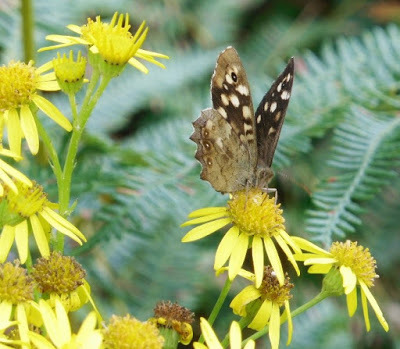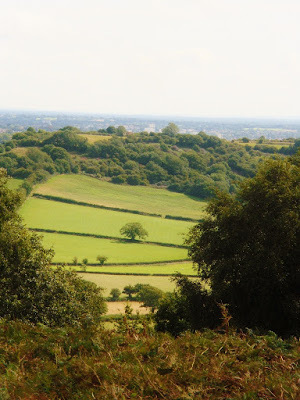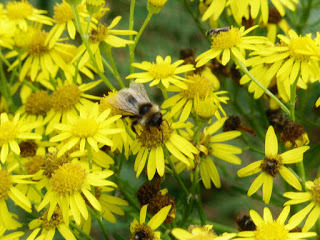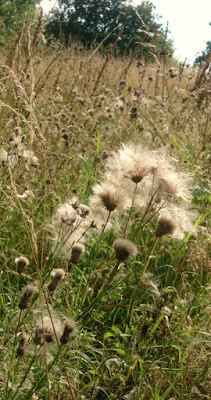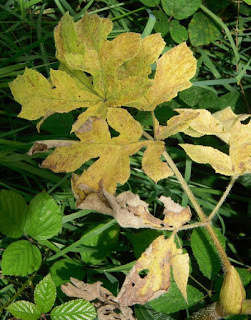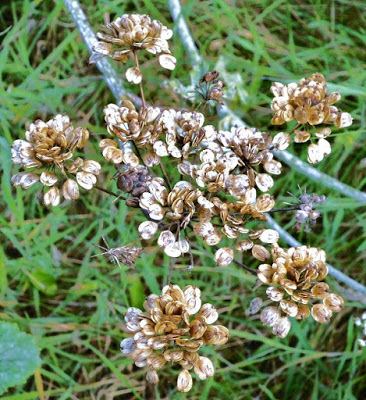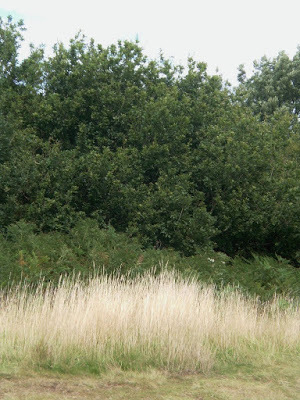Susan Price's Blog: Susan Price's Nennius Blog, page 6
October 16, 2015
A Day Off...
I've been hard at it, working on the Sterkarm rewrite, working at school events, at indie publishing... Suddenly I felt a strong need to run away into the hills, stretch the legs and get some fresh air.
I went to the Clent Hills, of course. May all Powers that be bless the National Trust, who saved them for Birmingham.
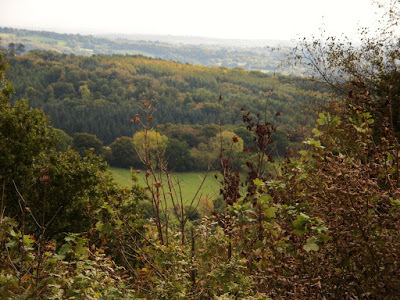 A View From A Clent Hill
A View From A Clent Hill
It wasn't a sunny day, and rather chilly, but the colours were bright...
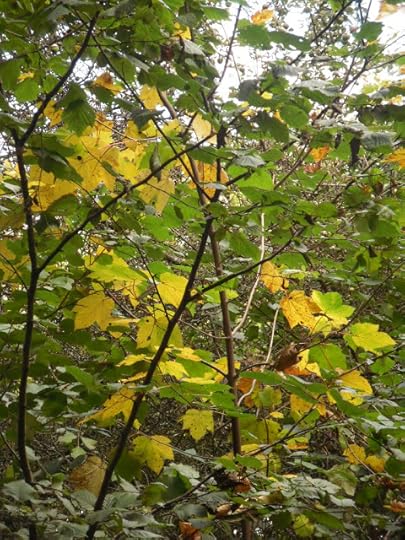


I've become quite interested in mushrooms and other fungi. They talk to the trees, are some of the largest living organisms on earth, are as much animals as plants, and have symbiotic relationships with oak-trees.You can eat some of them, and others are interestingly poisonous. What's not to like?
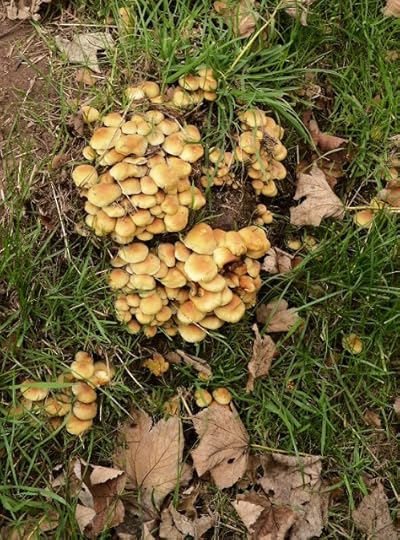
It all makes me rather glumly aware of how much there is to know and how little of my ignorance I am even aware of.

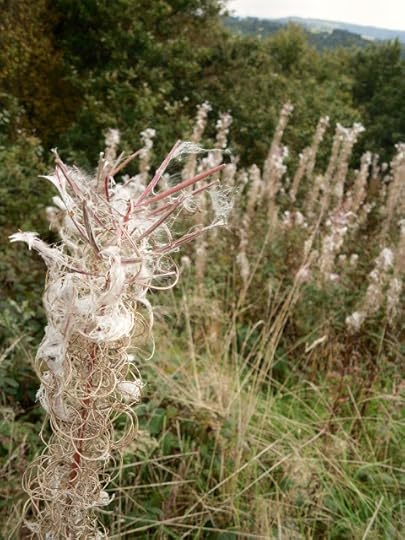
On my way back to the car, I decided to take a more adventurous route, straight down a steep wooded slope. So I started into the trees...
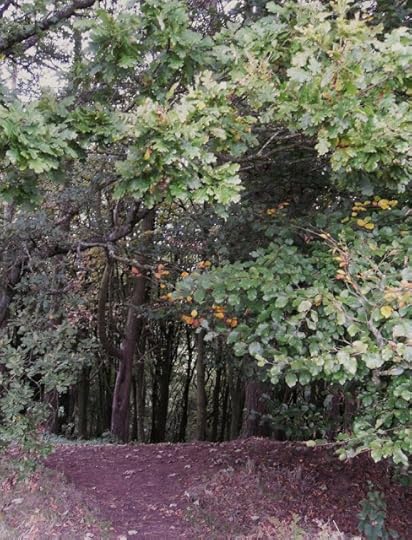
However, I'd hardly taken a step under those trees when I saw an elderly couple - both of them grey-haired and well wrapped up - having a snog. So I withdrew discreetly and left them to it. I even restrained from taking photographs.
But it just goes to prove that while this is in bloom...
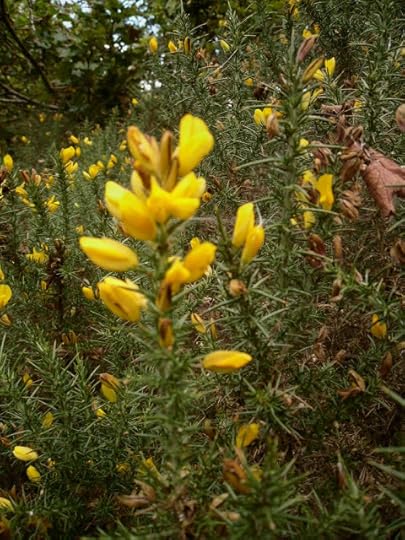
... kissing is in season.
I went to the Clent Hills, of course. May all Powers that be bless the National Trust, who saved them for Birmingham.
 A View From A Clent Hill
A View From A Clent HillIt wasn't a sunny day, and rather chilly, but the colours were bright...



I've become quite interested in mushrooms and other fungi. They talk to the trees, are some of the largest living organisms on earth, are as much animals as plants, and have symbiotic relationships with oak-trees.You can eat some of them, and others are interestingly poisonous. What's not to like?

It all makes me rather glumly aware of how much there is to know and how little of my ignorance I am even aware of.


On my way back to the car, I decided to take a more adventurous route, straight down a steep wooded slope. So I started into the trees...

However, I'd hardly taken a step under those trees when I saw an elderly couple - both of them grey-haired and well wrapped up - having a snog. So I withdrew discreetly and left them to it. I even restrained from taking photographs.
But it just goes to prove that while this is in bloom...

... kissing is in season.
Published on October 16, 2015 16:00
October 2, 2015
Biffo - The Missing Weeks...
I was browsing on-line, as I do when plot-wrangling threatens to
implode my brain, and I came across this, questioning whether putting up posters about your missing cat ever helps you regain the cat.
It reminded me of my beloved ex-cat, Biffo, and the time he went missing.
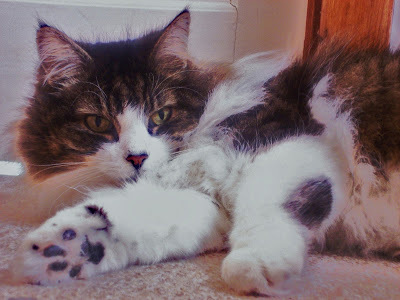
It wasn't long after he moved in with me. I followed the rules for a cat-move. I kept him strictly inside for the requisite two weeks, buttered his paws and gave him cream and tuna, and other treats, designed to convince him that he'd fallen on his paws, and there was nowhere he'd rather be.
But I had to open the door and let him out eventually, because he'd always had freedom to come and go as he pleased before.
His first ventures into my back-yard and street went well, and he returned to base for food. And then he went out and didn't return. Not that day, not that night, not the next morning.
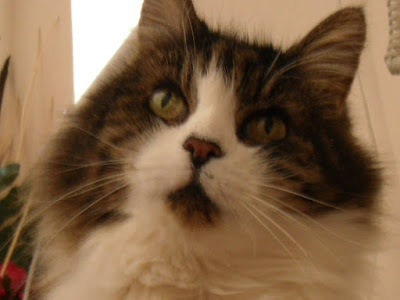 I knocked on doors and asked neighbours to check their sheds. Still no Biffo. I concluded that, sadly, Biffo had probably been killed by a car.
I knocked on doors and asked neighbours to check their sheds. Still no Biffo. I concluded that, sadly, Biffo had probably been killed by a car.
But Davy, who was Can-Opener No. 2 (I was No. 3) refused to accept this. He was very attached to Biffo. Davy persuaded me to print off some flyers and we posted them through doors for several streets around.
The result, after a week, was one phone-call from a concerned man who asked if we'd found our cat yet. He and his wife, he said, would be distraight if they lost their cat, and they felt for us. But no, he'd seen no cat like the one we described.
Davy still refused to give up. On his insistence - Davy is really the hero of this story - we toured the neighbourhood again, talking to people we met in their gardens, asking if they'd see our flyer and if they had any news. It was a warm, sunny autumn Saturday, in late October or early November, because the annual barrage of nightly fireworks had been going on for, well, nights.
We wandered onto a patch of overgrown waste ground that backed onto some gardens, because it was the kind of place that a lost cat might hide during the day, or hunt at dusk. We stood there for some while, talking. Davy seemed sure that Biffo was simply exploring his new area. I argued that he was more likely trying to find his way back to his previous home, and was disorientated in the strange streets.
We stood there, talking, for some time and a woman came out of her house into her back yard, which we appeared to be staring into. Could she help us, she asked, in that special tone that means: 'What are you up to, you suspicious types?'
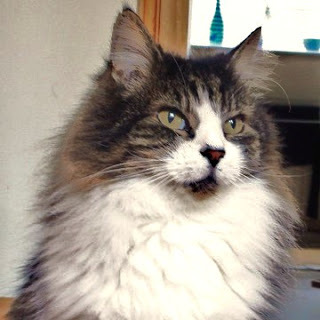
I apologised, and explained that we were looking for our cat. Mollified, she said she'd seen a cat, one she hadn't seen before, sitting on the fence posts at the edge of the waste ground, staring into the scrub. In other words, a cat hunting.
I asked what the cat had looked like. 'It was a big cat,' she said. Now, on seeing Biffo for the first time, people said either, 'Oh what a beautiful cat,' or 'Oh, what a big cat.' Sometimes, both. I asked for more detail and the description - grey, striped, big bushy tail - all fitted Biffo.
We thanked the woman, and returned to the road. I was thinking hard. A lost and scared cat, forced to find its own food, would want, I thought, somewhere quiet and hidden to lie up and hide during the day; somewhere there were plenty of small mice and other little creatures (and Biffo did catch mice and rats) and somewhere that people put out food.
Assuming that he was continuing on down the hill, was he going to find anywhere like that?
Yes, he was. Near the bottom of that very hill was the house where a good friend of mine lived. It was a corner plot, raisedup above street level. Most of its long garden consisted of a steep bank sloping down to the street, thickly grown with trees, bushes and briars. There were apple trees, and plum, hawthorn and wild roses: a miniature urban wood. My friend had never tried to do anything with it: had simply left it to itself.
She's also keen on wild-life and birds, and puts out food and water, every single night. She makes up sandwiches for the foxes (I kid you not) and sets out cat-food for the hedgehogs. There are peanuts for the badgers. If Biffo was still alive, I reckoned he would have sniffed out my friend's place - and once he'd found it, he'd stay there.
I knew my friend had guests that afternoon, so didn't interrupt her, but I phoned her as soon as I could and described Biffo. A very large cat, a tabby, mostly grey but with a sandy undercoat. He has the look of a wildcat, I said, with a very thick, bushy grey tail, ringed with black. Amber eyes. Very upright, pointed ears. A big fluffy snow-white 'shirt-front.' Big paws. Hind legs longer than his front legs.
That was Saturday evening. The very next morning, early, the
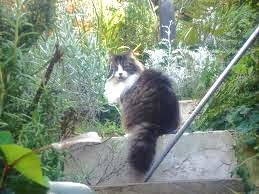 phone rang and it was my friend. She asked me to describe my missing cat again. Then she said, 'I got up last night to watch the foxes - ' Which she often does, because she's a life-long insomniac. 'And there was a cat just like the one you described eating from the hedgehog's bowl.'
phone rang and it was my friend. She asked me to describe my missing cat again. Then she said, 'I got up last night to watch the foxes - ' Which she often does, because she's a life-long insomniac. 'And there was a cat just like the one you described eating from the hedgehog's bowl.'
So I phoned Davy, and he grabbed his cat-basket and drove over immediately. As soon as his car pulled onto my friend's drive, Biffo emerged from the bushes, wailing. A very bright cat, he recognised individual car engines, and he knew rescue had arrived.
There was no palaver, that day, about catching him and getting him into the cat-basket. Davy said he almost threw himself inside, purring with relief and gratitude. You know, freedom is one thing - the sky your roof, and your candle a star and all that. But a nice warm sofa and as much cat-food as you can eat is not something to give up lightly.
After that adventure - he was on the loose for three weeks, with fireworks exploding every night - he stayed much closer to home, though he still spent most of every day outside.
He's been gone for good since 2010. I still miss him. In fact, as I lay in bed the other night, I heard him licking his paws beside me, as I did immediately after he died.
So, did the flyers succeed in reuniting us with our missing cat? No. But Davy's determination to look for him, and asking questions around the neighbourhood - and my doing a bit of writerly imagining on, 'How would a cat think?' - led us to recovering him. And to eight further years of very happy cat life.
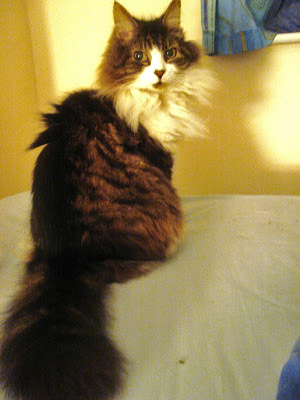
He's welcome to come back in the night, and lick his paws and wipe his ears as often as he likes.
implode my brain, and I came across this, questioning whether putting up posters about your missing cat ever helps you regain the cat.
It reminded me of my beloved ex-cat, Biffo, and the time he went missing.

It wasn't long after he moved in with me. I followed the rules for a cat-move. I kept him strictly inside for the requisite two weeks, buttered his paws and gave him cream and tuna, and other treats, designed to convince him that he'd fallen on his paws, and there was nowhere he'd rather be.
But I had to open the door and let him out eventually, because he'd always had freedom to come and go as he pleased before.
His first ventures into my back-yard and street went well, and he returned to base for food. And then he went out and didn't return. Not that day, not that night, not the next morning.
 I knocked on doors and asked neighbours to check their sheds. Still no Biffo. I concluded that, sadly, Biffo had probably been killed by a car.
I knocked on doors and asked neighbours to check their sheds. Still no Biffo. I concluded that, sadly, Biffo had probably been killed by a car.But Davy, who was Can-Opener No. 2 (I was No. 3) refused to accept this. He was very attached to Biffo. Davy persuaded me to print off some flyers and we posted them through doors for several streets around.
The result, after a week, was one phone-call from a concerned man who asked if we'd found our cat yet. He and his wife, he said, would be distraight if they lost their cat, and they felt for us. But no, he'd seen no cat like the one we described.
Davy still refused to give up. On his insistence - Davy is really the hero of this story - we toured the neighbourhood again, talking to people we met in their gardens, asking if they'd see our flyer and if they had any news. It was a warm, sunny autumn Saturday, in late October or early November, because the annual barrage of nightly fireworks had been going on for, well, nights.
We wandered onto a patch of overgrown waste ground that backed onto some gardens, because it was the kind of place that a lost cat might hide during the day, or hunt at dusk. We stood there for some while, talking. Davy seemed sure that Biffo was simply exploring his new area. I argued that he was more likely trying to find his way back to his previous home, and was disorientated in the strange streets.
We stood there, talking, for some time and a woman came out of her house into her back yard, which we appeared to be staring into. Could she help us, she asked, in that special tone that means: 'What are you up to, you suspicious types?'

I apologised, and explained that we were looking for our cat. Mollified, she said she'd seen a cat, one she hadn't seen before, sitting on the fence posts at the edge of the waste ground, staring into the scrub. In other words, a cat hunting.
I asked what the cat had looked like. 'It was a big cat,' she said. Now, on seeing Biffo for the first time, people said either, 'Oh what a beautiful cat,' or 'Oh, what a big cat.' Sometimes, both. I asked for more detail and the description - grey, striped, big bushy tail - all fitted Biffo.
We thanked the woman, and returned to the road. I was thinking hard. A lost and scared cat, forced to find its own food, would want, I thought, somewhere quiet and hidden to lie up and hide during the day; somewhere there were plenty of small mice and other little creatures (and Biffo did catch mice and rats) and somewhere that people put out food.
Assuming that he was continuing on down the hill, was he going to find anywhere like that?
Yes, he was. Near the bottom of that very hill was the house where a good friend of mine lived. It was a corner plot, raisedup above street level. Most of its long garden consisted of a steep bank sloping down to the street, thickly grown with trees, bushes and briars. There were apple trees, and plum, hawthorn and wild roses: a miniature urban wood. My friend had never tried to do anything with it: had simply left it to itself.
She's also keen on wild-life and birds, and puts out food and water, every single night. She makes up sandwiches for the foxes (I kid you not) and sets out cat-food for the hedgehogs. There are peanuts for the badgers. If Biffo was still alive, I reckoned he would have sniffed out my friend's place - and once he'd found it, he'd stay there.
I knew my friend had guests that afternoon, so didn't interrupt her, but I phoned her as soon as I could and described Biffo. A very large cat, a tabby, mostly grey but with a sandy undercoat. He has the look of a wildcat, I said, with a very thick, bushy grey tail, ringed with black. Amber eyes. Very upright, pointed ears. A big fluffy snow-white 'shirt-front.' Big paws. Hind legs longer than his front legs.
That was Saturday evening. The very next morning, early, the
 phone rang and it was my friend. She asked me to describe my missing cat again. Then she said, 'I got up last night to watch the foxes - ' Which she often does, because she's a life-long insomniac. 'And there was a cat just like the one you described eating from the hedgehog's bowl.'
phone rang and it was my friend. She asked me to describe my missing cat again. Then she said, 'I got up last night to watch the foxes - ' Which she often does, because she's a life-long insomniac. 'And there was a cat just like the one you described eating from the hedgehog's bowl.'So I phoned Davy, and he grabbed his cat-basket and drove over immediately. As soon as his car pulled onto my friend's drive, Biffo emerged from the bushes, wailing. A very bright cat, he recognised individual car engines, and he knew rescue had arrived.
There was no palaver, that day, about catching him and getting him into the cat-basket. Davy said he almost threw himself inside, purring with relief and gratitude. You know, freedom is one thing - the sky your roof, and your candle a star and all that. But a nice warm sofa and as much cat-food as you can eat is not something to give up lightly.
After that adventure - he was on the loose for three weeks, with fireworks exploding every night - he stayed much closer to home, though he still spent most of every day outside.
He's been gone for good since 2010. I still miss him. In fact, as I lay in bed the other night, I heard him licking his paws beside me, as I did immediately after he died.
So, did the flyers succeed in reuniting us with our missing cat? No. But Davy's determination to look for him, and asking questions around the neighbourhood - and my doing a bit of writerly imagining on, 'How would a cat think?' - led us to recovering him. And to eight further years of very happy cat life.

He's welcome to come back in the night, and lick his paws and wipe his ears as often as he likes.
Published on October 02, 2015 16:00
September 25, 2015
A Conversation With... Joan Lennon
It’s been a while since I’ve put up a conversation blog, but I’m very
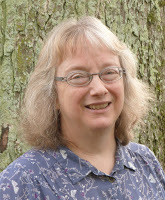 Joan Lennonhappy, today, to be talking to my friend and fellow-writer, Joan Lennon — Joan lives in the Kingdom of Fife at the top of an old Victorian house. She's been writing full-time since she hit the ripe old age of 50 and plans to be still scribbling when the coffin lid goes down.
Joan Lennonhappy, today, to be talking to my friend and fellow-writer, Joan Lennon — Joan lives in the Kingdom of Fife at the top of an old Victorian house. She's been writing full-time since she hit the ripe old age of 50 and plans to be still scribbling when the coffin lid goes down. She writes funny stuff for 5-7, historical stuff for 8-12, fantasy, sci-fi and poetry for any age you care to mention. You can find out more about her books on her main website.
Her new YA novel Silver Skin, inspired by the Stone Age village of Skara Brae that disappeared for thousands of years, has its own website - www.silver-skin.co.uk.
Sue: Being nosy, I’ve always wondered where in Canada you came from originally?
Joan: I was born in Toronto. Then we lived in London (Ontario). Then Windsor (Ontario). Then I escaped back to Toronto. At least we managed one non-British rip-off name!
Sue: Still being nosy, were you of Scots' descent? I know that quite a lot of Canadians are, as many people thrown off their land during the Clearances emigrated to Canada.Joan: Scots' descent? Probably! My father's father came to Canada from Donaghadee and lots of the Protestants in Northern Ireland were Scottish imports. There's some French Huguenot on my mother's side, if you go back a bit. Oh, and English weavers and lace-makers. My mother was born in China - does that count?
Sue: I’m quite curious about how your mother came to be born in China — but perhaps another blog.
We’re flattered that you chose to come and live in Britain. How did that come about?
Joan: Flu brought me to Scotland. It was like this - in my Masters year there was one of those really knock-out flus going about the campus and I didn't pick up from it for ages, and my mum and dad invited me to go B&Bing with them in Britain to perk me up. And it was lovely and I was duly perked.
 Iona - Wikimedia Commons, Robert Guthrie
Iona - Wikimedia Commons, Robert GuthrieAnd one day we visited the Abbey on Iona and there was a sign up in the cloister - "Wanted - Secretary for a Year." So I applied, not thinking for a second that I'd get it. I'm pretty sure the person they wanted fell through, and so I got this odd letter through the post, weeks later, back in Canada. And the rest is, well, not history, but still a long time ago. I worked there 1978-1979 - by the end of that, it was totally clear Scotland was the place for me.
Sue: I love Iona. It’s the only place in Britain I know of where you’re sure to hear a corncrake. It will always make me think of you now.Joan: I must go back - it's been decades!
Sue: You won't be sorry.
Joan: But I’d like to make it clear that I do not describe myself as a Canadian ex-pat. That's a term I've never really understood. I'm an immigrant. And, after just shy of 40 years here, I am pretty damn Scottish as well (even though I don't like haggis).
Sue: I never doubted it! I think of you as Scottish and Canadian, and, to my mind, it lends you a certain cachet. I know a lot of Scots, but only one Scottish-Canadian. — I do like haggis, though.Joan: Thank you - Scottish-Canadian, Canadian-Scot, that woman with the weird voice - take your pick.
Sue: 'That witty, clever woman, who never fails to make me laugh.'Joan: If flu brought me to Scotland, my teeth introduced me to
When did your fascination with the Stone Age and Skara Brae begin? - I always think of 'Third Rock From The Sun'where the (Earthling) Professor of Archaeology, Mary, smiles goofily and says, "Oh, I was always Daddy's little girl and, of course, like all little girls, I was totally obsessed with Paleolithic Archaeology." It made me laugh out loud because, when the siblings and I were children on the beach, instead of sandcastles, we used to build neolithic tombs from flat pieces of slate, with lolly-sticks for the bodies and shells for grave goods.
 Wikimedia Commons - Malcolm MorrisSkara Brae.
Wikimedia Commons - Malcolm MorrisSkara Brae.When I was little, I spent a lot of time at the dentist, with the drilling noise and that smell, and the National Geographic magazines in the waiting room were the one good thing about it all. And that's where I first learned about Skara Brae in Orkney. The pictures were so evocative and the thought of an entire village, hidden under the sand for thousands of years, and then revealed overnight by a killer storm, made the hairs on my imagination stand on end. And I love Third Rock from the Sun!
Sue: Oh, so do I, and Big Bang Theory! - But that’s for that other blog.
I also have some pretty horrible memories of the dentist, with that rubber mask, and the smell of the gas, and waking up with blood in your mouth… But I don’t remember any word of Skara Brae to comfort me.
I think I must have been a teenager when I first read about it - possibly because I was always reading up on the Vikings - and the Vikings left runes at Maeshowe — and if an author is mentioning Maeshowe, then they might as well throw in a mention of Skara Brae. Like you, I found the whole account of the abandoned, buried village, and its reappearance after a gale, completely irresistible. Sometime in my early teens I formed an ambition: to go to Oslo and see the Viking Ship Museum, and to go to Orkney and see Skara Brae and Maeshowe.
Joan: I've seen your photos of the Oslo Viking ship - could it BE more beautiful? I would love to see it myself.
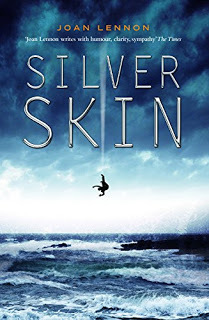 Silver Skin by Joan Lennon
Silver Skin by Joan LennonSue: But I wanted to talk about your wonderful book, Silver Skin. When did the idea of writing something based in/on/around Skara Brae come to you? Have you always wanted to do it — or did the idea of the book form slowly as you learned more about Orkney and the Stone Age?
Joan: I'd visited the Skara Brae site a couple of times over the years, but the final push to write Silver Skin came when I was doing some author visits to schools on Orkney. I was talking about my series, The Wickit Chronicles , set in the Fens in medieval England, of all places/times. During a Q&A, one of the pupils asked me why didn't I write a book set in Orkney? And I realised I was desperate to do just that. The story of Rab and Cait and angry old Voy grew out of that moment.
Sue: I think it was lurking around in your subconcious, just waiting...Joan: Rab from the far future and Cait and Voy from the Stone Age were there from the start. The young Victorian bride Mrs Trevelyan came into my head, quite quietly, later on in the writing. There is a rambling, bleak, cold, old house near Skara Brae that's open to the
Did you always intend to bring the future - and the 19th century period of the uncovering gale — into the story? Was there ever a time when you meant to set it entirely in the Stone Age?
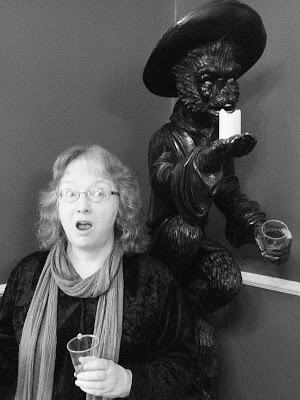 Joan experiencing an atmosphere...public - Skaill House - that I visited one time with my sister. It had ... an atmosphere. I've been trying to think of another word for "bleak" but I can't — not that seems as right. But it wasn't just bleak. It had a powerful feeling to it, however you put it, and Mrs Trevelyan came out of that visit. She's made up, of course - they're all made up - but totally real to me!
Joan experiencing an atmosphere...public - Skaill House - that I visited one time with my sister. It had ... an atmosphere. I've been trying to think of another word for "bleak" but I can't — not that seems as right. But it wasn't just bleak. It had a powerful feeling to it, however you put it, and Mrs Trevelyan came out of that visit. She's made up, of course - they're all made up - but totally real to me! Sue: Oooh! I think you should write a ghost story set in Skaill House! Perhaps featuring Mrs. Trevelyan. I’d like to know more about her.Joan: I'd like to spend more time with her too - she's got a lot of spirit ... There's a joke in there somewhere ... Now I've got a question for you - do you fancy talking about genre? How do bookshops and publishers categorise the Sterkarm books, for example?
Sue: I'd say, with a bit of difficulty. I think of it as history mixed with fantasy — because the time-travel is dressed up as science, but it’s pure fantasy. Other people tell me it’s science-fiction — but I think that's misleading as there's no more than a nod to science in it. It came about — as I would venture a guess Silver Skin did — because I wanted to compare and contrast modern life with the life of the border reivers. What I didn’t want was any supernatural element to explain the time-travel. I wanted that to be as matter-of-fact and routine as catching a bus. So I invented the Time Tube — and then could have a lot of fun with imagining that the reivers make sense of it by understanding the people from the future as Elves, and the Time Tube as the hillside opening for the Elves to come out.Joan: I tell people Silver Skin is a sci-fi historical adventure romance.
Sue: Sounds about right!Joan: Somebody described it as "genre-bending" - which I like the sound of, though I can't say that was the plan. Really I just wrote it the way it wanted to be written, just as soon as I could figure that out, one page at a time.
Sue: You wrote it the way it wanted to be written! Exactly! The Sterkarm books were the same. They made it clear from the start that they did not want to be straightforward historical novels, set entirely in the past. I think 'sci-fi historical adventure romance' about covers them too. Perhaps, between us, we've started a new genre?
Thanks to Joan, for giving up time to help me make this blog.Silver Skin is an absorbing, thought-provoking read, especially if you like Sci-fi Historical Adventure Romance.
There's more chat about Silver Skin here on An Awfully BigBlog Adventure
And you can find out more about Joan - and probably be made to laugh - here.
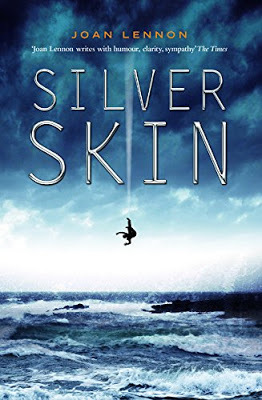
Find Silver Skin on Amazon
Book UK US
Ebook UK US
Read a review, published in The Guardian, here.
Published on September 25, 2015 16:00
September 18, 2015
Scrabbling Through The Dictionary...
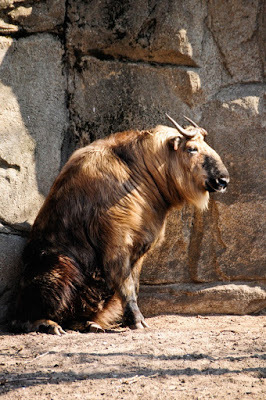 From Wikipedia, Creative Commons
From Wikipedia, Creative CommonsThis is 'a massive bovid of mountainous South Asia, with a shaggy coat, short legs, and horns that point back and up.' I thought myself fairly knowledgeable about the fauna and flora of the world, but this particular beastie had escaped my notice until I was scanning through the Scrabble dictionary. This 'antelope-goat' is a takin, and that's a useful word to know if you have a K (score, 5.)
The Official Scrabble dictionary is a gem, and even more fun to flip through than the OED, since virtually every word in it is obscure, with strange definitions.
I had letters to spell 'gane' and picked up the dictionary to check that this Scottish past-tense of 'gone' would be allowed. Instead I discovered that 'gane' is a variant of the word 'gangue.' which means 'the valueless material in ore.' I would have gone a whole lifetime without knowing that, if it hadn't been for Scrabble. I bet there are people who spent all day picking the valueless bits out of ore and chucking them away, who don't know that they are gangue-chuckers.
And this, this is a quaich, a small drinking cup, traditional to the
 An oaken quaich, wikipedia commonsGaelic speaking Highlands. It uses (in the English game) a 'q' (10) and a 'c' (3) and an 'h' (4) and so would score you 20, even if you couldn't get it on a double or triple scoring square.
An oaken quaich, wikipedia commonsGaelic speaking Highlands. It uses (in the English game) a 'q' (10) and a 'c' (3) and an 'h' (4) and so would score you 20, even if you couldn't get it on a double or triple scoring square.Words that use 'q' are always of great interest to Scrabble players - and most of them know by heart all the words where 'Q' can be used without a 'u' - qi, qat, suq. Here are some with 'u'.
Quonk - an unintentional noise while broadcasting.
Quop - to pulsate.
Quohog - an edible clam.
Quich - to move. (Is this the origin of 'the quick and the dead?')
Queach - a thicket.
My interest in the meaning of the words betrays me as a lesser player. The real enthusiasts have no interest in the meaning at all, something which passes all understanding as far as I'm concerned. How can you hear a strange new word and not want to know what it means?
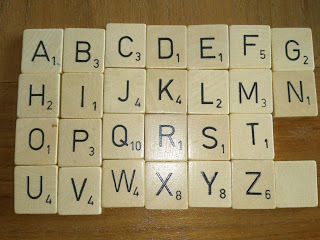 Wikipedia Commons: Dutch tiles. Their letters score differently 'J' is another letter that gets the Scrabblers' attention, because it scores 8. (In English. Its different for the Dutch.)
Wikipedia Commons: Dutch tiles. Their letters score differently 'J' is another letter that gets the Scrabblers' attention, because it scores 8. (In English. Its different for the Dutch.)I particuarly liked 'jarp' which means to break or smash - but more exactly, means to break or smash the shell of an egg - but more exactly still, means to break or smash the shell of an egg, especially at Easter. I do like a word with an exact definition, me. Savour it until Easter, and then jarp them eggs, jarp 'em.
'Jirble' means to 'pour carelessly.' You can hear that booze jirbling...
I liked 'fizgig' - two each for the 'g's, four for the 'f' and ten for the 'z.' It means to 'inform to the police.'
'Dow' is 'archaic' and means 'to be of worth.' Is this word behind 'dowry' and 'dowager'? It's in 'endow' too, surely.
'Skelf' was known to Davy without any dictionary - he often had a skelf in his finger as a lad. It means 'splinter.' 'Skelp' means to beat.
'Wanhope' reminded me of Jonathan Strange - it means 'disillusion.' There she goes, her necklace studded with broken promises and regrets, and her train of finest wanhope.
As winter heaves into view, I'll remind you that 'pogonip' means an icy winter fog.
A word Davy taught me, but which doesn't seem to be in the Scrabble dictionary, is 'teuchter' - pronounced something like 'ChooKter.' It means 'a big, healthy, strong but unsophisticated farm-boy.' The dictionary does offer 'quashie' - an unsophisticated Caribbean peasant.
My scrabble game is improving, folks. I hounded Davy so close recently that he conceded the game before the end (though he said it was only because he was tired.) Next game, he beat me by only 32 points - and the game after that by only 16.
I will skelp the teuchter yet.
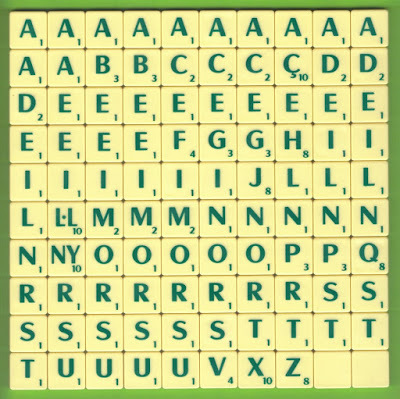 Wikipedia Commons: Catalan Scrabble Tiles
Wikipedia Commons: Catalan Scrabble Tiles
Published on September 18, 2015 16:00
September 11, 2015
September 4, 2015
The Dragon Like Yoda Talks -- Not!
Here I go again, doing what I'm told you absolutely should not do -
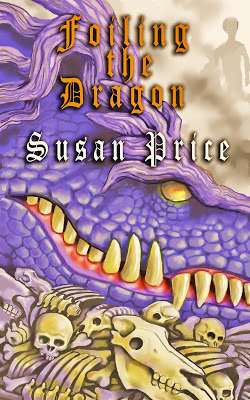 Foiling The Dragon by Susan Pricethat is, talking back to your critics.
Foiling The Dragon by Susan Pricethat is, talking back to your critics.
I did it here, when people said my villain in the Sterkarm books, James Windsor, was not believable - and now I'm going to defend my poetry-loving dragon in Foiling The Dragon.
I recently put Foiling The Dragon. out as a paperback and e-book. It is, as the strapline informs you, 'A light-hearted fantasy of poets, sorceresses, dragons — and wrapping paper.' It's not epic fantasy. It's meant to amuse for a few hours, and maybe make you smile.
On Amazon it's collected some positive reviews. J. Mathews says,
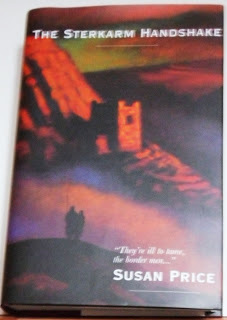 The Sterkarm Handshake by Susan Price
The Sterkarm Handshake by Susan Price
D. Lamb says:
Of course, I would say that, wouldn't I?
One of the reviews underneath, by 'Aldrea Alien,' makes some good points about wavering point of view (which I know is a besetting sin of mine, and which I have been discussing with my editor, Matrice, as I work on Sterkarm 3. Fair cop, guv.
But Aldrea A does allow that 'the dragon was a hoot' and the book was 'worth reading for the dragon scenes alone.'
Another review - which may even have inspired D. Lamb and J. Mathews to their good deeds - is headlined: '"Foiling The Dragon" Is Very Very Bad.' Why? Because the 'characters are not particularly likeable' and 'the big scary dragon talks like some kind of dodgy medieval Yoda ("Thou to me the way will show"). Even A. Alien, although thinking the dragon the best thing in the book, says the dragon, 'spoke a little like Yoda.'
Well, I could discuss whether or not characters should always be 'likeable' for hours - and I think it's especially questionable for them to be entirely 'likeable' in something which aims at being funny, since most humour involves telling the truth about ourselves.
Humour isn't about the big, heroic, chivalric, handsome, strong epic fantasy vision of ourselves that we all like to indulge in now and again. Instead, it undercuts all that by telling the truth about how weak, cowardly, selfish, envious, slothful and all those other sinful things we are in reality.
Some people like the shiny heroic version better, but that doesn't mean that the funnier version doesn't have its value. However, that's a matter of taste and opinion. As I said when defending my Sterkarm villain:
Here's the dragon:
The dragon like a German into English literally translating speaks. This because a Nordic, Germanic dragon it is. Yoda its creator's mind never entered. Okay, I'll give the terminating verbs a rest. I can tell you how that phrase 'terminal verbs' got into my vocabulary, though. From my cousin, a fluent German speaker, who explained that German has a different way of ordering its parts of speech from English. German almost always places the verb 'in the terminal postition.'
And, you see, I was writing about this dragon... It was definately a dragon in the tradition of the North - a fire-breathing, carnivorous beast, red in tooth and claw, bearing little good-will towards anybody or anything. To misquote the much missed Pratchett: 'The nearest a dragon can come to understanding what "friend" means is "an enemy who is still alive."' There is also a tradition that these mythical beasts are intelligent and sometimes even talk. It suited me and my plot to have an intelligent, talking dragon. So, if a great Germanic, gold-hoarding worm opens its gob and speaks - what does it sound like? Presumably, when it has occasion to speak to its own kind, it speaks in dragon. But it's been alive a long time, and it's picked up a bit of the languages spoken by these pestilential forked vermin that swarm all over the place. And, being a Nordic, Germanic dragon, presumably the first such language it picked up was a Germanic language... So it speaks with a German terminal verb. Now this reasoning of mine might have as many holes as a sieve - but it has nothing whatsoever to do with that cuddly little goblin from a futuristic Space Opera.
Why, when characterising an ancient, ferocious Northern mythological creature, would I have chosen to copy a kindly, cuddly alien from a science-fiction film? I probably have to break this gently to 'A Customer', but: the whole world is not encompassed by Star Wars (and I speak as someone who loved Star Wars. Saw it when it first came out.) People were thinking and inventing pre-Star Wars. Even post-Star Wars, people can manage to invent without reference to it. Sometimes their ideas have similarities. It's sort of like parallell evolution - faced with the same problems, entirely different creatures come up with a similar solutions, and end up looking very alike, even though they are not at all related. So it comes down to this: If your opinion is that my amusing little fantasy is very very bad, fine. You didn't like it, it wasn't what you were looking for. I'm sorry I didn't succeed in entertaining you. Better luck with your book choices in future. (And strewth, I can sympathise, I've thrown enough books aside myself.) But - The dragon like Yoda talks - NOT!
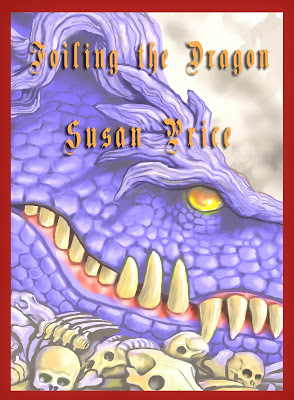
Foiling The DragonPaperback UK US
Foiling The DragonEbook UK US
 Foiling The Dragon by Susan Pricethat is, talking back to your critics.
Foiling The Dragon by Susan Pricethat is, talking back to your critics.I did it here, when people said my villain in the Sterkarm books, James Windsor, was not believable - and now I'm going to defend my poetry-loving dragon in Foiling The Dragon.
I recently put Foiling The Dragon. out as a paperback and e-book. It is, as the strapline informs you, 'A light-hearted fantasy of poets, sorceresses, dragons — and wrapping paper.' It's not epic fantasy. It's meant to amuse for a few hours, and maybe make you smile.
On Amazon it's collected some positive reviews. J. Mathews says,
'I enjoyed this book as a child, and have just read it again. I found it equally enjoyable.'Thank you, J. Mathews. I don't know who you are, but I greatly appreciate your taking the time and trouble to post a positive review.
 The Sterkarm Handshake by Susan Price
The Sterkarm Handshake by Susan PriceD. Lamb says:
Drily funny reversal of the usual medieval fantasy stereotypes... Anti-hero, anti-king and even a bit anti-Shakespeare - what's not to like?Thank you, D. Lamb. Again, I've no idea who you are but, for me, you get it. You describe the book wot I wrote.
Of course, I would say that, wouldn't I?
One of the reviews underneath, by 'Aldrea Alien,' makes some good points about wavering point of view (which I know is a besetting sin of mine, and which I have been discussing with my editor, Matrice, as I work on Sterkarm 3. Fair cop, guv.
But Aldrea A does allow that 'the dragon was a hoot' and the book was 'worth reading for the dragon scenes alone.'
Another review - which may even have inspired D. Lamb and J. Mathews to their good deeds - is headlined: '"Foiling The Dragon" Is Very Very Bad.' Why? Because the 'characters are not particularly likeable' and 'the big scary dragon talks like some kind of dodgy medieval Yoda ("Thou to me the way will show"). Even A. Alien, although thinking the dragon the best thing in the book, says the dragon, 'spoke a little like Yoda.'
Well, I could discuss whether or not characters should always be 'likeable' for hours - and I think it's especially questionable for them to be entirely 'likeable' in something which aims at being funny, since most humour involves telling the truth about ourselves.
Humour isn't about the big, heroic, chivalric, handsome, strong epic fantasy vision of ourselves that we all like to indulge in now and again. Instead, it undercuts all that by telling the truth about how weak, cowardly, selfish, envious, slothful and all those other sinful things we are in reality.
Some people like the shiny heroic version better, but that doesn't mean that the funnier version doesn't have its value. However, that's a matter of taste and opinion. As I said when defending my Sterkarm villain:
I’m neither surprised nor dismayed that some people dislike some of my books. I had my reasons for writing it the way I did; but other people would have made different choices, and dislike those I made. Fair enough.The point I would like to take issue with - and I suppose it's a bit daft of me to be annoyed by it, I admit, but it nevertheless irks - is the suggestion that I based the dragon on Yoda, from Star Wars. That the dragon 'talks like Yoda.' That I copied this from the film.
Here's the dragon:
...in the roofed and dim back of the cave, there was a heap of... gold coins, and plates, gold jugs, gold trays, and something that looked very like a crown. It was these things, sliding down from their heap, that had made the metallic noise. It was the reason they had slid that worried Paul more. Lying on top of the heap was — an animal. A very big animal. It was curled up, its back towards Paul. A back covered in scales. And spikes. A long tail, also edged with spikes, trailed down from the heap of gold and along the floor of the cave. The tip of the tail ended in an arrow-shaped point, and twitched slightly. Its general colour was greenish, but some of the scales had a reddish, coppery sheen...Its sides rose and fell, and more coins slid down from the heap. Paul made a strangled sound as his stifled breath at last escaped him, and he had to gulp for another. After that gulp he thought it was time to edge in a casual, slow, but still pretty nippy way for the cave entrance. He’d got no further than moving one foot when the gold began to cascade in all directions as the dragon’s shoulders twisted. A neck rose, uncoiling, and turning the head towards him. Two eyes — forward-facing, focusing, predator’s eyes — lazily opened in its mask. Two huge, smokily yellow and glowing eyes, with narrow black triangular centres, sharpened on him.The mouth opened — and opened — and opened, showing a black lining and four long, sharp, dripping wet teeth. A black, forked tongue coiled backwards and then flicked forwards. A gust of smoke blew from the mouth, carrying towards him that stink of damp and smouldering. The thing squirmed on its pile of gold, twisting round to face him, scattering coins and crowns and sword-belts. Wings unfolded, rustling against rock, fanning the burning stink towards him. What a size it was! He could feel the strength of those wings from where he stood, His own legs gave way and he sat on the rock, shrank himself down, trying to be small. Raised up as he was, on top of the boulder, the dragon’s head was above him. Even if he could have run for the cave entrance, what would have been the use? That long neck would have snaked out… He didn’t want to think any further. "Best for thee it would be," said the dragon, "if thou a bard wert.”
The dragon like a German into English literally translating speaks. This because a Nordic, Germanic dragon it is. Yoda its creator's mind never entered. Okay, I'll give the terminating verbs a rest. I can tell you how that phrase 'terminal verbs' got into my vocabulary, though. From my cousin, a fluent German speaker, who explained that German has a different way of ordering its parts of speech from English. German almost always places the verb 'in the terminal postition.'
And, you see, I was writing about this dragon... It was definately a dragon in the tradition of the North - a fire-breathing, carnivorous beast, red in tooth and claw, bearing little good-will towards anybody or anything. To misquote the much missed Pratchett: 'The nearest a dragon can come to understanding what "friend" means is "an enemy who is still alive."' There is also a tradition that these mythical beasts are intelligent and sometimes even talk. It suited me and my plot to have an intelligent, talking dragon. So, if a great Germanic, gold-hoarding worm opens its gob and speaks - what does it sound like? Presumably, when it has occasion to speak to its own kind, it speaks in dragon. But it's been alive a long time, and it's picked up a bit of the languages spoken by these pestilential forked vermin that swarm all over the place. And, being a Nordic, Germanic dragon, presumably the first such language it picked up was a Germanic language... So it speaks with a German terminal verb. Now this reasoning of mine might have as many holes as a sieve - but it has nothing whatsoever to do with that cuddly little goblin from a futuristic Space Opera.
Why, when characterising an ancient, ferocious Northern mythological creature, would I have chosen to copy a kindly, cuddly alien from a science-fiction film? I probably have to break this gently to 'A Customer', but: the whole world is not encompassed by Star Wars (and I speak as someone who loved Star Wars. Saw it when it first came out.) People were thinking and inventing pre-Star Wars. Even post-Star Wars, people can manage to invent without reference to it. Sometimes their ideas have similarities. It's sort of like parallell evolution - faced with the same problems, entirely different creatures come up with a similar solutions, and end up looking very alike, even though they are not at all related. So it comes down to this: If your opinion is that my amusing little fantasy is very very bad, fine. You didn't like it, it wasn't what you were looking for. I'm sorry I didn't succeed in entertaining you. Better luck with your book choices in future. (And strewth, I can sympathise, I've thrown enough books aside myself.) But - The dragon like Yoda talks - NOT!

Foiling The DragonPaperback UK US
Foiling The DragonEbook UK US
Published on September 04, 2015 16:00
August 21, 2015
Taking Apart The Sterkarms...
Here I sit, on the floor, surrounded by gear wheels and springs,
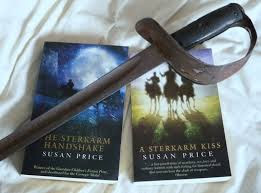 The Sterkarm Handshake and A Sterkarm Kiss by Susan Pricesprockets and puppet heads, ratchets and screws.
The Sterkarm Handshake and A Sterkarm Kiss by Susan Pricesprockets and puppet heads, ratchets and screws.
For the past couple of weeks I've been taking the Sterkarm books apart and trying to figure out how they go. There are bits of Book Two: A Sterkarm Kiss lying around here somewhere. And one or two parts from Book One: The Sterkarm Handshake have rolled under the settee.
Mostly, though, the bits are from Book Three, which has a working title of A Sterkarm Embrace - but I'm still not sure whether to go with that or not.
My editor, Matrice Hussey, gave me a very detailed consideration of the book, and one of the points she made is that I had begun it very abruptly, at the point where Book Two ends.
Not everyone who picks up Book Three, she said, is going to have read the first two. Or, if they have, they might have forgotten them - so it makes sense to have a longer lead in, to set the scene, and fill in a little of the background. As most of the actions takes place in the 16th Century, it would be good to have an idea of what was going on in the 21st.
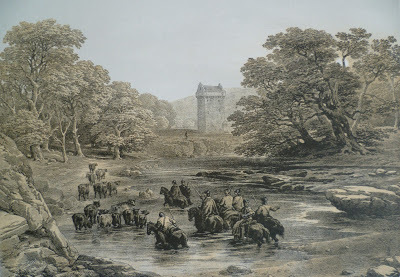
So I've pulling things apart and rewriting, with these points in mind. I think Matrice's advice is turning out to be very good - but lord, it's been nipping my head full sore.
I had an uncle who was notorious for taking apart watches and clocks, and then not being able to put them back together again. I feel his pain. Where does this bit go? Will that bit work if I force it in there?
This clockwork figure is almost working again, but I've lost its head. - Oh, now that delicate bit of wiring has snapped.
I keep telling myself I'm enjoying it. I like rewriting. I will sort it out. I will, I will...
 The Sterkarm Handshake and A Sterkarm Kiss by Susan Pricesprockets and puppet heads, ratchets and screws.
The Sterkarm Handshake and A Sterkarm Kiss by Susan Pricesprockets and puppet heads, ratchets and screws.For the past couple of weeks I've been taking the Sterkarm books apart and trying to figure out how they go. There are bits of Book Two: A Sterkarm Kiss lying around here somewhere. And one or two parts from Book One: The Sterkarm Handshake have rolled under the settee.
Mostly, though, the bits are from Book Three, which has a working title of A Sterkarm Embrace - but I'm still not sure whether to go with that or not.
My editor, Matrice Hussey, gave me a very detailed consideration of the book, and one of the points she made is that I had begun it very abruptly, at the point where Book Two ends.
Not everyone who picks up Book Three, she said, is going to have read the first two. Or, if they have, they might have forgotten them - so it makes sense to have a longer lead in, to set the scene, and fill in a little of the background. As most of the actions takes place in the 16th Century, it would be good to have an idea of what was going on in the 21st.

So I've pulling things apart and rewriting, with these points in mind. I think Matrice's advice is turning out to be very good - but lord, it's been nipping my head full sore.
I had an uncle who was notorious for taking apart watches and clocks, and then not being able to put them back together again. I feel his pain. Where does this bit go? Will that bit work if I force it in there?
This clockwork figure is almost working again, but I've lost its head. - Oh, now that delicate bit of wiring has snapped.
I keep telling myself I'm enjoying it. I like rewriting. I will sort it out. I will, I will...
Published on August 21, 2015 16:00
July 31, 2015
A Shaman's Handbook - a review
Writing In The House Of Dreams by Jenny Alexander
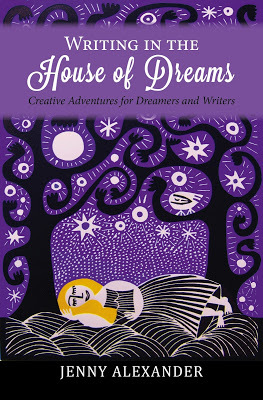 'Writing In The House Of Dreams' by Jenny Alexander
'Writing In The House Of Dreams' by Jenny Alexander
This is an astonishing book. I don't think I've read another like it.
It's a book of writing exercises and advice on how to write - but, equally, exercises and advice on how to live another life, in your dreams. Jenny Alexander has spent a lifetime exploring and coming to know that other world that we visit when we dream. She's spent twenty years writing and revising and adding to this book.
I feel it's as much a shaman's handbook as a writer's.
I remember a conversation with Jenny where she told me that she'd become a writer because of her dreams. She'd always been creative, but had suppressed that side of herself, and gone to University instead of to Art school. That other, suppressed side of herself reacted with fury, sending her terrible nightmares where she killed herself. [You can read a record of our conversation here.]
 Jenny AlexanderFinding no real help in dealing with her nightmares from doctors, counsellors or psychiatrists, she began exploring her dream world for herself.
Jenny AlexanderFinding no real help in dealing with her nightmares from doctors, counsellors or psychiatrists, she began exploring her dream world for herself.
For most of her life - certainly for all of her writing life - she has been, perhaps, more aware of that other self, The Dreamer, The Creative Self, than most of us.
Having moved from an exploration of dreams into writing, Jenny taught workshops both on writing and dreaming. In this book she has pulled together a lifetime's experience of both.
It starts with 'The Ordinary World' - how a child leaves 'the magical world of childhood, where teddies can talk...and monsters hide in the shadows.' This is close to the dream-world, from which writers - from which all artists - have always drawn inspiration.
Then there's 'Crossing the Threshold' of the House of Dreams - in which Jenny urges us to let go of the Western idea that dreams are merely a rehashing of waking events, or something to be 'interpreted' for psychological meaning. That, Jenny says, is simply rationalising something which disturbs us, so we can dismiss a terrifying nightmare, or a sequence of strange dream events, with a glib, 'Oh, I know what that meant.' - Perhaps we do 'know what it meant' on one level - but perhaps the dream is larger and contains more than its meaning to us at that moment.
Another approach, instead of dismissing the nightmare with a rationalisation, is to enter it and explore it as a reality. Then you are approaching and communicating with the source of your own creativity, even with the worst, most sinister nightmare.
This makes the chapter, 'The Beast In The Basement' a necessary one, as it arms you with techniques to deal with the Beast when it charges out - and here Jenny shares some of her own dream-battles and victories.
Then comes 'Making Yourself At Home' in the House of Dreams. We're all familiar with the weird images that dreams can throw up but Jenny, as a seasoned explorer of the dream-world, can assure us that as we become more familiar with it, the dream-world 'stabilises' and even has its own familiar landscape, time-sequence and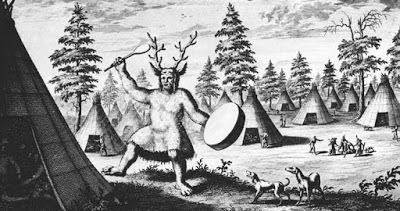 Shaman: from Wikimedia Commonsinhabitants. Is, in fact, another world, with its own reality.
Shaman: from Wikimedia Commonsinhabitants. Is, in fact, another world, with its own reality.
This is something that the shamans, who climbed or descended ladders into the spirit-world, always maintained. Now, I have never been one to insist that a belief is 'wisdom' simply because it's old. On the other hand, age doesn't mean a belief has no basis either.
Jenny is a writer, and this book is partly about writing. The value of exploring this dream-world, for writers, she says, is that 'it makes us aware of the continuous flow of stories and images moving through us all the time, like an underground stream.'
Jenny has moved far beyond my piddling knowledge of such things, into areas that I doubt I shall ever experience - but again and again, as I read the book, she described things that I recognised and have experienced. Which makes me pay more attention to the rest.
She talks about dreams that are indistinguishable from waking life. I am well aware of such dreams. When I wrote my book 'The Ghost Drum', I was writing about a shaman who spirit-travels in other worlds. I needed to be able to imagine what that was like - and after some thought, decided to conceive of these other worlds as the places where we go when we dream. This gave me a firm basis: I was able to believe, entirely, in my shaman 'turning and stepping into another world' simply by imagining this as a kind of dreaming.
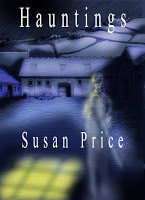 This worked for me because, throughout my entire life, I have dreamed in full-colour, 3-D, stereo-sound surround, with a sense of touch thrown in. In my dreams, if I put a hand into water, I felt the wetness. If there was snow, I felt the bite of the cold. In one of my short stories 'The Dreamer' (included in my collection, Hauntings) I used an experience - which I've had - of dreaming that I'd woken and begun my day, only to find, after half an hour or so of what seemed perfectly normal waking life that I was, in fact, still asleep and had only dreamed waking. Which raises the question: how do we know which waking, which world, is the 'real' one?
This worked for me because, throughout my entire life, I have dreamed in full-colour, 3-D, stereo-sound surround, with a sense of touch thrown in. In my dreams, if I put a hand into water, I felt the wetness. If there was snow, I felt the bite of the cold. In one of my short stories 'The Dreamer' (included in my collection, Hauntings) I used an experience - which I've had - of dreaming that I'd woken and begun my day, only to find, after half an hour or so of what seemed perfectly normal waking life that I was, in fact, still asleep and had only dreamed waking. Which raises the question: how do we know which waking, which world, is the 'real' one?
Jenny mentions lucid dreams and predictive dreams. Well, I've never personally had a lucid dream - which is where you know, while dreaming, that you are dreaming, and can take control of the dream and direct events, or ask questions of dream inhabitants. But once, many years ago, when I expressed doubts that such a thing as lucid dreaming existed, my brother said, no, he had them all the time. So commonly, in fact, that he'd assumed everyone had them and had never thought them worth mentioning.
He is also quite matter-of-fact about predictive dreams. Has them all the time. That's where the sense of deja-vu comes from, he says.
I've had what you might call predictive dreams myself, though never in any dramatic, save-people-from-an-aircrash kind of way. The foreseen events are mundane - but you're left wondering how and why you dreamt of this little incident two nights ago. There are 'sensible explanations' about the unreliability of memory and our eagerness to see patterns - explanations which I've accepted but not altogether believed.
If I clearly remember buying milk on Tuesday, nobody tells me to doubt my memory. So when I wake up on Tuesday morning, clearly remembering a dream where I knock my favourite yellow mug off the dresser and break its handle, why should I doubt that memory just because, on Thursday, I knock my favourite yellow mug off the dresser and break its handle?
Jenny's experience is that you rarely recognise that a dream is predictive unless you keep dream-diaries and look back through them. Her diaries, when re-read, contained a quite eerie prediction of a miscarriage, disregarded at the time.
My 'predictive dreams' and those of my brother are usually about small, insignificant events, of no importance even to us. A cup being dropped and broken, or, say, stubbing your toe painfully. They're only noteable because they were dreamed before they happened.
All this makes me trust Jenny when she reports on her exploration of the dream country far beyond where I've ventured.
I can also vouch for the effectiveness of her writing exercises - my story, Mow Top, which is found in Overheard In A Graveyard, sprang fully formed from her 'collage' exercise.
'Writing In The House Of Dreams' - altogether a fascinating, original book, whether you're interested in writing, dreams, or both.
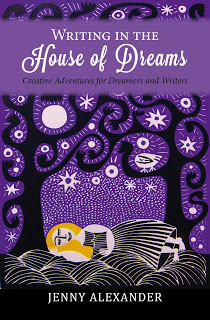
Paperback edition
UK US
Kindle edition UK US
 'Writing In The House Of Dreams' by Jenny Alexander
'Writing In The House Of Dreams' by Jenny AlexanderThis is an astonishing book. I don't think I've read another like it.
It's a book of writing exercises and advice on how to write - but, equally, exercises and advice on how to live another life, in your dreams. Jenny Alexander has spent a lifetime exploring and coming to know that other world that we visit when we dream. She's spent twenty years writing and revising and adding to this book.
I feel it's as much a shaman's handbook as a writer's.
I remember a conversation with Jenny where she told me that she'd become a writer because of her dreams. She'd always been creative, but had suppressed that side of herself, and gone to University instead of to Art school. That other, suppressed side of herself reacted with fury, sending her terrible nightmares where she killed herself. [You can read a record of our conversation here.]
 Jenny AlexanderFinding no real help in dealing with her nightmares from doctors, counsellors or psychiatrists, she began exploring her dream world for herself.
Jenny AlexanderFinding no real help in dealing with her nightmares from doctors, counsellors or psychiatrists, she began exploring her dream world for herself.For most of her life - certainly for all of her writing life - she has been, perhaps, more aware of that other self, The Dreamer, The Creative Self, than most of us.
Having moved from an exploration of dreams into writing, Jenny taught workshops both on writing and dreaming. In this book she has pulled together a lifetime's experience of both.
It starts with 'The Ordinary World' - how a child leaves 'the magical world of childhood, where teddies can talk...and monsters hide in the shadows.' This is close to the dream-world, from which writers - from which all artists - have always drawn inspiration.
Then there's 'Crossing the Threshold' of the House of Dreams - in which Jenny urges us to let go of the Western idea that dreams are merely a rehashing of waking events, or something to be 'interpreted' for psychological meaning. That, Jenny says, is simply rationalising something which disturbs us, so we can dismiss a terrifying nightmare, or a sequence of strange dream events, with a glib, 'Oh, I know what that meant.' - Perhaps we do 'know what it meant' on one level - but perhaps the dream is larger and contains more than its meaning to us at that moment.
Another approach, instead of dismissing the nightmare with a rationalisation, is to enter it and explore it as a reality. Then you are approaching and communicating with the source of your own creativity, even with the worst, most sinister nightmare.
This makes the chapter, 'The Beast In The Basement' a necessary one, as it arms you with techniques to deal with the Beast when it charges out - and here Jenny shares some of her own dream-battles and victories.
Then comes 'Making Yourself At Home' in the House of Dreams. We're all familiar with the weird images that dreams can throw up but Jenny, as a seasoned explorer of the dream-world, can assure us that as we become more familiar with it, the dream-world 'stabilises' and even has its own familiar landscape, time-sequence and
 Shaman: from Wikimedia Commonsinhabitants. Is, in fact, another world, with its own reality.
Shaman: from Wikimedia Commonsinhabitants. Is, in fact, another world, with its own reality.This is something that the shamans, who climbed or descended ladders into the spirit-world, always maintained. Now, I have never been one to insist that a belief is 'wisdom' simply because it's old. On the other hand, age doesn't mean a belief has no basis either.
Jenny is a writer, and this book is partly about writing. The value of exploring this dream-world, for writers, she says, is that 'it makes us aware of the continuous flow of stories and images moving through us all the time, like an underground stream.'
Jenny has moved far beyond my piddling knowledge of such things, into areas that I doubt I shall ever experience - but again and again, as I read the book, she described things that I recognised and have experienced. Which makes me pay more attention to the rest.
She talks about dreams that are indistinguishable from waking life. I am well aware of such dreams. When I wrote my book 'The Ghost Drum', I was writing about a shaman who spirit-travels in other worlds. I needed to be able to imagine what that was like - and after some thought, decided to conceive of these other worlds as the places where we go when we dream. This gave me a firm basis: I was able to believe, entirely, in my shaman 'turning and stepping into another world' simply by imagining this as a kind of dreaming.
 This worked for me because, throughout my entire life, I have dreamed in full-colour, 3-D, stereo-sound surround, with a sense of touch thrown in. In my dreams, if I put a hand into water, I felt the wetness. If there was snow, I felt the bite of the cold. In one of my short stories 'The Dreamer' (included in my collection, Hauntings) I used an experience - which I've had - of dreaming that I'd woken and begun my day, only to find, after half an hour or so of what seemed perfectly normal waking life that I was, in fact, still asleep and had only dreamed waking. Which raises the question: how do we know which waking, which world, is the 'real' one?
This worked for me because, throughout my entire life, I have dreamed in full-colour, 3-D, stereo-sound surround, with a sense of touch thrown in. In my dreams, if I put a hand into water, I felt the wetness. If there was snow, I felt the bite of the cold. In one of my short stories 'The Dreamer' (included in my collection, Hauntings) I used an experience - which I've had - of dreaming that I'd woken and begun my day, only to find, after half an hour or so of what seemed perfectly normal waking life that I was, in fact, still asleep and had only dreamed waking. Which raises the question: how do we know which waking, which world, is the 'real' one?Jenny mentions lucid dreams and predictive dreams. Well, I've never personally had a lucid dream - which is where you know, while dreaming, that you are dreaming, and can take control of the dream and direct events, or ask questions of dream inhabitants. But once, many years ago, when I expressed doubts that such a thing as lucid dreaming existed, my brother said, no, he had them all the time. So commonly, in fact, that he'd assumed everyone had them and had never thought them worth mentioning.
He is also quite matter-of-fact about predictive dreams. Has them all the time. That's where the sense of deja-vu comes from, he says.
I've had what you might call predictive dreams myself, though never in any dramatic, save-people-from-an-aircrash kind of way. The foreseen events are mundane - but you're left wondering how and why you dreamt of this little incident two nights ago. There are 'sensible explanations' about the unreliability of memory and our eagerness to see patterns - explanations which I've accepted but not altogether believed.
If I clearly remember buying milk on Tuesday, nobody tells me to doubt my memory. So when I wake up on Tuesday morning, clearly remembering a dream where I knock my favourite yellow mug off the dresser and break its handle, why should I doubt that memory just because, on Thursday, I knock my favourite yellow mug off the dresser and break its handle?
Jenny's experience is that you rarely recognise that a dream is predictive unless you keep dream-diaries and look back through them. Her diaries, when re-read, contained a quite eerie prediction of a miscarriage, disregarded at the time.
My 'predictive dreams' and those of my brother are usually about small, insignificant events, of no importance even to us. A cup being dropped and broken, or, say, stubbing your toe painfully. They're only noteable because they were dreamed before they happened.
All this makes me trust Jenny when she reports on her exploration of the dream country far beyond where I've ventured.
I can also vouch for the effectiveness of her writing exercises - my story, Mow Top, which is found in Overheard In A Graveyard, sprang fully formed from her 'collage' exercise.
'Writing In The House Of Dreams' - altogether a fascinating, original book, whether you're interested in writing, dreams, or both.

Paperback edition
UK US
Kindle edition UK US
Published on July 31, 2015 16:00
July 24, 2015
Happy Birthday, Happy Birthday...
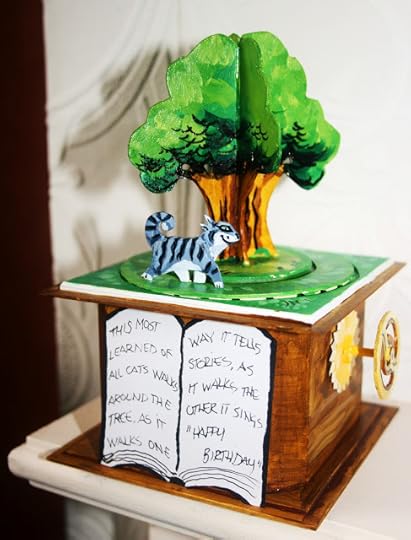
"This most learned of all cats walks around the tree. As it walks one way, it tells stories. As it walks the other, it sings, 'Happy Birthday.'
I had several birthday cards recently. This was the most personal and the best. It was made by youngest brother, Adam - and it's the cat that walks round the tree, from the opening of my book, Ghost Drum . (Only, in the book - and Russian folktale - the cat sings songs in general as it walks the other way, and not specifically, 'Happy Birthday.')
The cat is painted to resemble my late and still lamented cat,
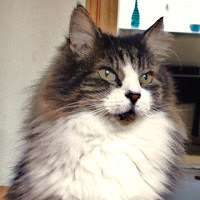 Biffo the Wonder Cat.Biffo. And that wheel on the side is not just for decoration, as you will see later if you stick with this blog.
Biffo the Wonder Cat.Biffo. And that wheel on the side is not just for decoration, as you will see later if you stick with this blog.I've never paid much attention to birthdays - in fact, I often have to be reminded by other people that it is my birthday. This year, even Google tried to remind me, but I missed it until it was pointed out to me.

(The little banner, brought up by a mouse-hover, says 'Happy Birthday, Susan.' Some will find this delightful, some sinister.)
But I'd forgotten again when brother Adam and Patti said they wanted 'to meet up for a drink,' I thought that was all there was to it - a drink and a chat in the pub. I was all for it. And there they came - bearing chocolate cake and presents.
And what presents! Not only the birthday card shown above, but a beautiful 'This Is Your Life' book, put together by Patti. (When it comes to thoughtful, individual presents, Patti is hard to beat.)
The book has photos of my parents that I didn't have myself. Patti had gone to other relatives and sought them out.
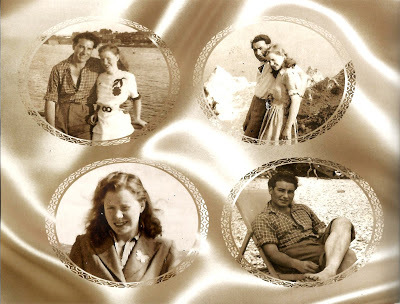 Mum and Dad at about a third of my age...
Mum and Dad at about a third of my age...It has photos of me and my siblings at all ages, of my books, of me in schools, of (below) most of my favourite people...
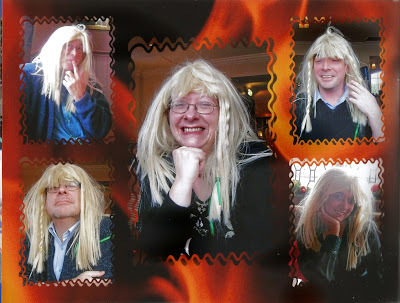
... here shown wearing the traditional ratty blonde Christmas wig of the Prices.
And at the end of the book, there is a bonus Blott cartoon!
But before that, this -
Sorry about the quality.
And now - Blott!



Discounted by up to 76%... Ghosts, Witches and Graveyards... To bring you a little chill in this humid, muggy summer weather (well, we're hoping for some anyway,) here's more discounts...Overheard In A Graveyard
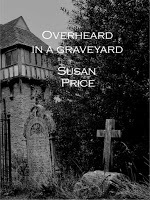 Nine haunting stories of the supernatural, of loss and longing, of those who walk between this world and the next…
Nine haunting stories of the supernatural, of loss and longing, of those who walk between this world and the next…With settings ranging from the ancient past to the modern world, but with everyone bringings its own chill...
Amazon UKAmazon US
The Bearwood Witch Zoe wants her dead boyfriend back.
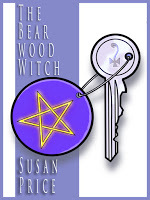
Since his death in a car crash, she’s been inconsolable.Time heals? He rests in peace? – don’t give her such crap. Only one thing will help - having him back in her arms.
She means to bring him back from the dead, no matter what it takes.
So she knocks on the door of the Bearwood witch, Elizabeth Beckerdyke’s...
A supernatural thiller, set in the modern world...
'The best thing about "The Bearwood Witch" is what other fantasy/horror books lack - a real sense of the uncanny and strange.' - Amazon review, R. M. Fisher
Amazon UKAmazon US
The Ghost Wife
 The Industrial Revolution is blackening the English countryside… Women and children hack at coal in darkness underground and drag loaded tubs like animals.
The Industrial Revolution is blackening the English countryside… Women and children hack at coal in darkness underground and drag loaded tubs like animals.Rattle is one of them – a dirty, pipe-smoking, swearing collier wench, who dresses and swaggers like a boy.
But she’s in love… With the young farmer who works the land on the hill above the mine. Jonathan Turner, a god-fearing, prim and proper Methodist.
Rattle is determined to have him. Except that he’s already married – to a ghost.
A historical, supernatural thriller...
Amazon UKAmazon US
Susan Price is an award winning writer, with work translated and published in many countries world-wide. Visit her Amazon page. Vist her website
Published on July 24, 2015 16:00
July 10, 2015
Come Into The Garden...

I'm really enjoying my garden this year. During my parents' last illness, and for several years after their deaths, I lost interest in it.
But perhaps I'm turning into my mother - or channelling her - or being haunted by her - because the interest seems to have come rushing back this year. (And you're welcome, Mom. Stay around. Put the kettle on.)
Maybe she's brought my Dad with her, because a large part of the interest stems from encouraging more wildlife into the garden, from mini-beasts up. Mother was mad about flowers, but Dad loved flowers, trees, insects, birds, animals, fish, stars, rocks... it would be quicker to list the things he wasn't interested in. (Sport: that about covers it.)
In the photo above, you see zebra grass, a red icelandic poppy and borage in the foreground.
Behind is the pond in the pot, roses, an oleandar in a pot (it belonged to my mother.)
Beyond that, a caramel heuch-something in a pot, set against blue campanula. Above them is an orange dahlia. To the dahlia's right is a plant called, I think, moly-somethingorother, which I love and encourage because its leaves hold the raindrops so beautifully. In fact, I think of it as 'the raindrop plant.'
Just below the white roses on the arch at the top of the garden, you can just glimpse the pink of the foxglove I planted in my 'wood.' It's the tiniest of woods, but there are trees, ferns, mushrooms (in season) rotting logs, violets, brambles - and now foxgloves.

The dog roses which grow through my neighbour's fence. They have a short flowering season, but I look forward to them for their lovely simplicity. I think I prefer them to garden roses.
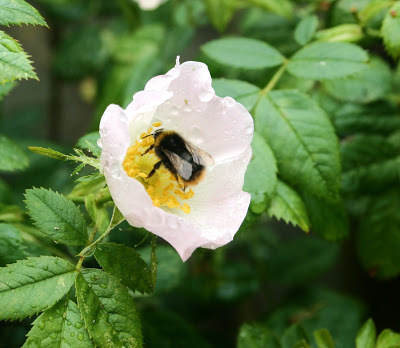
The bees love them too.
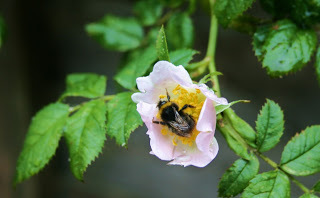
But then there's these roses growing opposite them, and I can't honestly say the bees ignore them. The scent is so rich and strong it can make you a bit dizzy on a hot day.
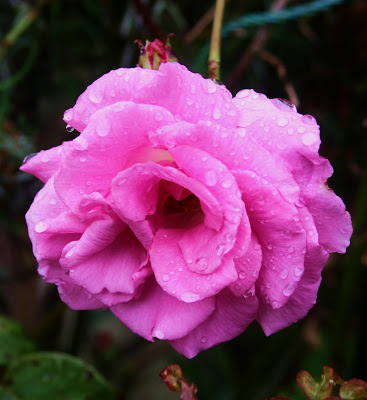
Close by the roses, we have sweet-peas - which family legend says were my Grandfather Price's favourite flower. Their scent is also heady.

Turn round and you can look into the pot pond, with its water forget-me-not.


At the other end of the gravel patch...
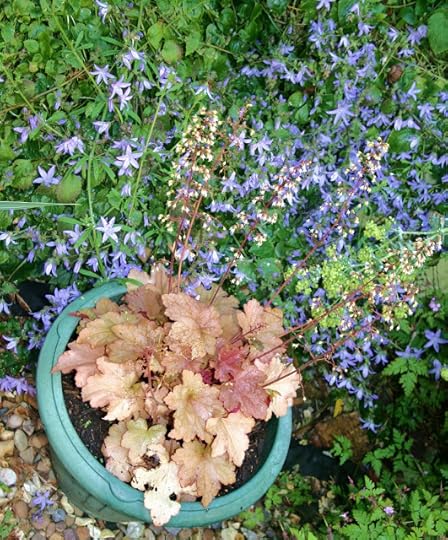
Looking up the slope of the garden... To the right, the dark blue, old fashioned columbines that my grandfather grew - ferns, ivy, a rhubarb plant and a bright red flower which my mother taught me to call a 'pelargonium', not a geranium. (There are pale pink hawksbill geraniums just to the left of the pelargonium.)

And finally, back near the house, bright yellow violas...
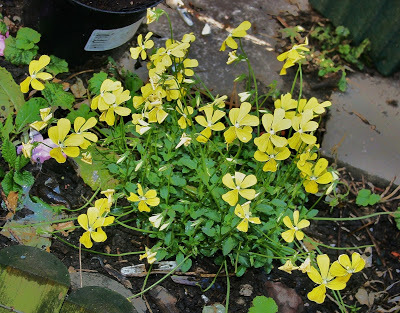 It's a small, scruffy garden, ill-kept and ill-weeded, but when I look out of my window at all that exuberant leafage and splashes of colour, it pleases me more than something neat and mown would.
It's a small, scruffy garden, ill-kept and ill-weeded, but when I look out of my window at all that exuberant leafage and splashes of colour, it pleases me more than something neat and mown would.
Published on July 10, 2015 16:00
Susan Price's Nennius Blog
"I have made a little heap of all I've found..."
"I have made a little heap of all I've found..."
...more
- Susan Price's profile
- 71 followers


